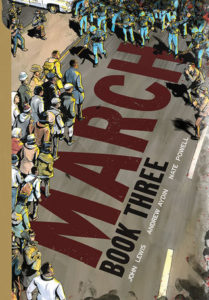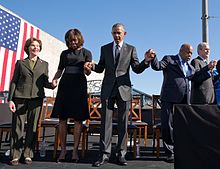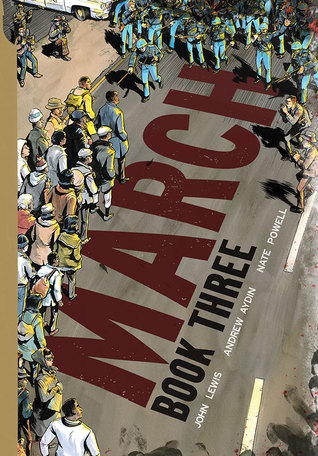March: Book Three
by John Lewis, Andrew Aydin (co-authors), Nate Powell (Illustrator)
 I finished the third volume in civil rights icon John Lewis’ graphic memoir about his early days in the movement leading up to the march from Selma to Montgomery, Alabama. (If you missed it my review of the first two books is here.) March: Book Three is the longest of the trilogy and covers the shortest amount of time. It opens in September 1963 with the bombing of the Sixteenth Street Baptist Church in Birmingham which killed four young girls. Everyone remembers the horror of that act of terrorism, but I didn’t know this was the church’s annual “Youth Day” and 24 other children were injured. The terrorists deliberately targeted African American children in their church. Shortly after that, a group of Eagle Scouts, who had just attended a clan rally, shot a 13-year-old black boy from his bicycle and killed him; and a police officer shot and killed a 16-year-old black youth who chucked a rock at a car full of teens who were celebrating the deaths of the girls. The book continues through to March 7, 1965, Bloody Sunday in Selma which included the beating death of Unitarian minister James Reeb, the later peaceful march to Montgomery, and the assassination of Viola Liuzzo, a 39-year-old mother from Detroit who was shuttling volunteers from Birmingham back to Selma. Four months later on August 6, President Johnson signed the 1965 Voting Rights Act into law.
I finished the third volume in civil rights icon John Lewis’ graphic memoir about his early days in the movement leading up to the march from Selma to Montgomery, Alabama. (If you missed it my review of the first two books is here.) March: Book Three is the longest of the trilogy and covers the shortest amount of time. It opens in September 1963 with the bombing of the Sixteenth Street Baptist Church in Birmingham which killed four young girls. Everyone remembers the horror of that act of terrorism, but I didn’t know this was the church’s annual “Youth Day” and 24 other children were injured. The terrorists deliberately targeted African American children in their church. Shortly after that, a group of Eagle Scouts, who had just attended a clan rally, shot a 13-year-old black boy from his bicycle and killed him; and a police officer shot and killed a 16-year-old black youth who chucked a rock at a car full of teens who were celebrating the deaths of the girls. The book continues through to March 7, 1965, Bloody Sunday in Selma which included the beating death of Unitarian minister James Reeb, the later peaceful march to Montgomery, and the assassination of Viola Liuzzo, a 39-year-old mother from Detroit who was shuttling volunteers from Birmingham back to Selma. Four months later on August 6, President Johnson signed the 1965 Voting Rights Act into law.
Although bookended with horrific violence, a lot of this book is dedicated to the behind the scenes politics and legal maneuvering both within and between the major players in the movement and government. As a policy wonk, I love to know how the sausage is made and don’t fault my heroes for being human. However, some folks might find these passages a tad boring or find their icons a bit tarnished. One of my favorite stories was when President Johnson called an impromptu press conference specifically to divert the newscasts from covering the jaw-dropping testimony of Mrs. Fannie Lou Hamer and her attempt to register to vote in Mississippi. She described in plain language the humiliation, verbal abuse, threats to her and her family, and the severe beating that left her lame. In order to show the competing narratives, the comic alternates frames with Mrs. Hamer’s testimony and the President’s press conference. Johnson’s ploy didn’t work. The broadcasts did switch to the President’s press conference in the afternoon, but they led their evening newscasts with Mrs. Hamer’s heartbreaking story when many more people watched. Johnson redeemed himself in his response to Bloody Sunday with a rousing address to the nation when he promised to do all in his power to pass the Voting Rights Act:
“At times, history and fate meet at a single time, in a single place to shape a turning point in man’s unending search for freedom. So it was at Lexington and Concord, so it was a century ago at Appomattox–so it was last week in Selma, Alabama. There, long-suffering men and women peacefully protested the denial of their rights as Americans. Many of them were brutally assaulted. One good man–a man of god–was killed. But there is cause for hope–and faith in our democracy–in what is happening here tonight. For the cries of pain and the hymns and protests of oppressed people have summoned into convocation all the majesty of this great government….But even if we pass this bill [the Voting Rights Act], the battle will not be over. What happened in Selma is part of a far larger movement which reaches into every section and state of America. It is the effort of American Negroes to secure for themselves the full blessings of American life. Their cause must be our cause, too. Because it is not just Negroes, but really it is all of us, who must overcome the crippling legacy of bigotry and injustice–and we SHALL overcome.”

John Lewis with President Obama, First Lady Michelle Obama, former President George W. Bush, and former First Lady Barbara Bush at the 50th Anniversary of the Selma Marches.
As with the other two volumes, this book is framed and interspersed with touching scenes from President Obama’s first inauguration which brought back that overwhelming sense of pride and optimism the majority of the nation felt at that time. It’s been heartening to read of the heroism of the Civil Rights activists and remember the long way we’ve come as individuals and as a society. The current political climate and the rise of hate crimes is discouraging, but we should take hope in Dr. Martin Luther King’s observation:
“The arc of the moral universe is long, but it bends toward justice.”
That bending can’t take place without our active involvement in building a more inclusive society and confronting injustice wherever we find it. Read the books. Be inspired. Get involved. Together we can make a difference!
Here’s a long interview with John Lewis at the Library of Congress in front of an young audience. Be inspired!
